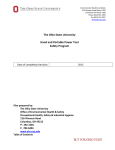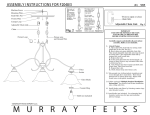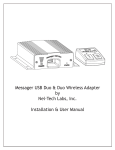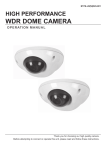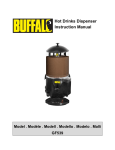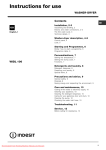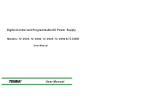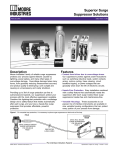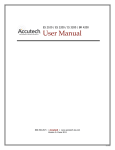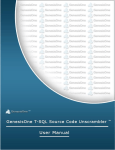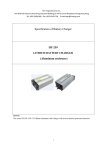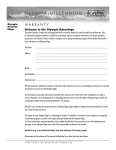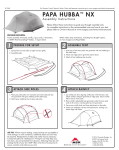Download - Armstrong Fluid Technology
Transcript
COM PA SS | HIG H - EFFICIEN C Y WE T- ROTO R CIRCU L ATO R S | I N S TA L L AT I O N A N D O P E R AT I N G I N S T R U C T I O N S File No: 10.895uk Date: march 28, 2014 Supersedes: 10.895uk Date: feb. 12, 2014 1.0 Symbols used in this document 1 6.0 Setting the pump 2 .0 General description 1 6.1 Pump setting for system type 4 5 2 .1 The Armstrong compass circulator pump 1 2 . 2Advantages of installing an Armstrong Compass 7.0Systems with bypass valve between flow and return pipes 2 2 8 .0Start-up 3 .0Installation 7.1 Purpose of bypass valve 4 5 5 3 .1Mounting 2 8 .1 Before start-up 5 3 . 2 Control box positions 2 8 . 2 Venting the pump 5 3 .3 Changing the control box position 2 9 .0 Pump settings and pump performance 4 .0Electrical connection 2 5 .0 Control panel 3 9 .1 Relation between pump setting and pump performance 5 5 .1 Elements on the control panel 3 5 . 2Display 3 5 .3 Light fields indicating the pump setting 3 w arning • Children shall not play with the appliance. Cleaning and user maintenance shall not be made by children without supervision. • If the supply cord is damaged, it must be replaced by the manufacturer or its service agent or a similarly qualified person in order to avoid a hazard. • The maximum ambient temperature is 40oc at which the pump is to be used. • It is not used for maintenance of swimming pool. • For indoor use only. • Use copper conductors only. • Do not install with motor above or below pump body. • Do not submerge. • Do not run pump dry. 7 11.0 Technical data and installation dimensions 7 11.1 Technical data 1.0 symbols used in this document warning The safety instructions must be followed to prevent potential personal injury. • The use of this product requires experience with and knowledge of the product. Only licensed or trained installers should install this product. • This appliance can be used by children aged from 8 years and above and persons with reduced physical, sensory or mental capabilities or lack of experience and knowledge if they have been given supervision or instruction concerning use of the appliance in a safe way and understand the hazards involved. 10.0Troubleshooting • Prior to installation, read these installation and operating instructions. Installation and operation must comply with local regulations and accepted codes of good practice. caution 5 The safety instructions must be followed to prevent potential malfunction or damage to the equipment. hint Hints or instructions that make the setup easier and ensure safe operation 2.0 gener al installation 2 .1 the armstrong compass circulator The Armstrong Compass circulator is designed for circulating water in closed hydronic heating systems or potable water systems. Model • Compass 25-60-130 ci • Compass 25-60-180 ci • Compass 25-60-180 ss 7 i n sta l l at i on & o p erat in g in str uction s Armstrong Compass 2 The Armstrong Compass includes operating modes suitable for systems with constant or variable flows, such as: • Underfloor heating systems • One-pipe (series) systems • Two-pipe (parallel) systems 3 . 2 control box positions The orientation of the display can be adjusted by removing four screws that attach the motor to the pump housing. Pump must be isolated from the system as this will open the system to the atmosphere. Armstrong Compass circulators incorporate Armstrong patented Design Envelope variable speed control technology with an ecm motor, enabling optimum energy efficiency and occupant comfort, with built-in control algorithms that can adapt to continuously changing system requirements. The Armstrong Compass features a user-friendly frontmounted control panel (see section 6) and wiring box for ease of installation. fig. 3 Control box positions warning 2 . 2 benefits of installing an armstrong compass circulator Eight different modes of operation to suit different system requirements: caution • Easily selectable from the front mounted display. • Modes include Sensorless demand-based control – Auto. • Power consumption and flow rate clearly displayed. Broad operating range, producing up to 6.1 meters of head and 4.5 m3/h of flow, provide versatility to cover the performance of a wide range of fixed speed or variable speed circulators. • Port to Port compatibility with existing Armstrong circulators and many competing models. Front mounted wiring box for ease of installation and service. The pumped liquid may be scalding hot and under high pressure. Drain the system or close the isolating valves on either side of the pump before the screws are removed. After the position of the control box has been rotated, refill the pump with system liquid before startup. 3 .3 changing the wiring box position Always install the circulator with the wiring box below or beside the motor. To change the wiring box position, remove the motor mounting screws and rotate the motor (see fig. 3). Ensure the gasket is intact and seated before evenly retightening the mounting screw to 6 - 7.5 Nm (4.5 - 5.5 lb/ft). 3 .0 installation 3 .1 mounting 4 .0 electrical connection Note: For convenience in future servicing, isolation valve can be used. The electrical wiring must be installed strictly in accordance with national electrical codes, local codes and regulations. correct installations incorrect installations 1 Electrical installation should be conducted by a qualified electrician. 2 Always make sure electric power is disconnected before wiring the circulator. The motor is designed for 50 Hz, 1 phase, 230 volt power. fig. 2 Mounting the Armstrong compass Arrows on the pump housing indicate the liquid flow direction through the pump. 1 Fit the two gaskets supplied when the pump is mounted in the pipe. 2 Install the pump with the motor shaft horizontal (see fig. 2). The wire shall be 0.75 to 1.5mm2 stranded wire with ordinary tough rubber sheathed flexible cord (h05rr-f or h05rn-f) or be 0.75 to 1.5mm2, rated for 60oc, solid wire To wire, loosen the screw from the wiring box cover and remove the screw and cover. Insert wires through supplied liquid-seal connector (installed) or other strain relief connector (not provided). Armstrong Compass i nsta l l a ti o n & o perati ng i nstr ucti o ns 3 5 .0 control panel Strip 0.5 cm (3 /af") of insulation from the ends of the three wires to be connected. To insert the wires into the terminal strip, press the terminal lever downward firmly. Insert the stripped wire into the opening and release the lever (see fig.4). Tug on the wire gently to ensure it is secured. 5 .1 elements on the control panel 1 2 Connect the live wire to terminal 'l1', the neutral wire to terminal 'l2/n', and the ground wire to terminal f fig. 4 Terminal strip (see fig. 5). a c b Place the terminal box cover and tighten screw. The motor is thermally protected so overload protection is not necessary. All that is required is a fused plug or circuit breaker in the power line. Electrical information can be found on the side of the terminal box. The electrical connections and protection must be carried out in accordance with local regulations. L1 L2/N fig. 5 Electrical connection fig. 6 Armstrong compass control panel The control panel on the Armstrong compass includes: position description a Display showing the actual pump power consumption in Watt and reference flow in m3/h. Display alternates between Watt and m3/h every 5 seconds. b Eight light fields indicating the pump setting c Mode Select button for changing pump setting Note m3/h value is a flow indicator only, not calibrated. 5 . 2 first power-up warning The pump must be connected to ground. The display is on and in Auto mode (position 0 in fig. 7) when the electricity has been switched on. The display shows the actual pump power consumption in Watts and reference flow in m3/h during operation. Note Display shows "E#" when the pump is not operating properly (see section 10). (# is between 0 to 4) 5 .3 display The Armstrong Compass has eight pump settings which can be selected with the press button. Every time the Mode button is pressed (see fig. 6, c) the pump setting is changed to the next option. A full cycle is eight button presses. The selected pump setting is indicated by one of eight different light fields (see fig. 7). i n sta l l at i on & o p erat in g in str uction s Armstrong Compass 4 speed 6.0 setting the pump pressure curve 7 4 6 2 5 auto fig. 7 Eight light fields 6.1 pump setting for system type 3 1 0 Note Optimum energy savings & comfort can be achieved by careful selection of the correct operation mode. Recommended and alternative pump settings according to fig. 8: image See section 9, Pump settings and pump performance, for information about the function of each setting. position description 0 auto (factory setting) 1 pc1 Lowest proportional-pressure curve 2 pc2 Highest proportional-pressure curve 3 pc3 Lowest constant-pressure curve 4 pc4 Highest constant-pressure curve 5 Constant curve, speed i 6 Constant curve, speed ii 7 Constant curve, speed iii system type recommended setting alternative setting a Underfloor auto heating Highest constantpressure curve (pc4)* or Lowest constantpressure curve (pc3)* b Two-pipe (parallel) systems auto Highest proportionalpressure (pc2)* c One-pipe (series) systems Lowest proportional-pressure curve (pc1)* Highest proportionalpressure (pc2)* * See pump settings and pump performance (section 9). single zone - constant resistance a radiant heat system recommended speed gas or oil boiler pressure curve alternative speed pressure curve circulation pump auto auto ok ok multiple zone - variable loads parallel recommended b speed pressure curve alternative speed pressure curve auto auto ok ok multiple zone - variable loads in series c recommended speed fig. 8 Selection of pump setting for system type pressure curve alternative speed pressure curve auto auto ok ok i nsta l l a ti o n & o perati ng i nstr ucti o ns Armstrong Compass 5 auto (underfloor heating and two-pipe (parallel) systems) auto function observes and adjusts the pump performance to satisfy the system requirement. The pump adapts to the system over time, it is recommended to leave the pump in the auto position at least one week before selecting other pump settings. 8. 2 venting the pump Changing from recommended (auto) to alternative pump setting: Heating systems are 'slow' systems that cannot be set to the optimum operation within minutes or hours. Once the pump is vented (the noise has ceased), set the pump mode according to the recommendations (see section 6). If the recommended pump setting does not give the desired comfort in some areas of the building, change the pump setting to the shown alternative. See pump settings and pump performance (section 9) for more details. 7.0 systems with bypass valve between flow and return pipes Even with system vented, air may be still be present in the pump. The air in the pump may cause noise but the noise should cease after a few minutes running. The venting process can be shortened by setting the pump to run at speed III for a short period of time (20 seconds). caution The pump must not run dry. 9.0 pump settings and pump performance 9.1 relation between pump setting and pump performance compass performance curves 7.5 7.1 purpose of bypass valve A Compass circulator can eliminate the need for a differential bypass valve when used in Auto or proportional pressure modes, because the circulator will reduce speed when the valves in the system close and the heat demand is reduced. If you are servicing an existing system with a bypass valve and you are replacing a fixed speed circulator with a Compass circulator, there is no need to remove the bypass valve. 8.0 start-up 8.1 before start-up Fill the system with liquid and properly vent the system before starting the pump. The required minimum inlet pressure in relation to liquid temperature must be available at the pump inlet (see section 11). 6.5 6.0 5.5 head - meter (m) The purpose of a differential pressure bypass valve is to ensure that the heat from the boiler can be distributed when all valves in the underfloor-heating circuits and/or thermostatic radiator valves are closed. These valves were commonly applied in multi zone systems with traditional fixed speed pumps. 7.0 5.0 4.5 pc3 pc4 4.0 3.5 3.0 2.5 auto pc1 pc2 2.0 1.5 1.0 0.5 iii i ii 0 0 0.5 1.0 1.5 2.5 2.0 3.0 3.5 4.0 flow - m 3 /h speed pressure curve iii ii pc4 pc2 i pc3 pc1 au to fig. 10 Pump setting in relation to pump performance 4.5 5.0 i n sta l l at i on & o p erat in g in str uction s Armstrong Compass 6 Select the optimum setting: The Compass circulator comes with 8 modes of operation. There are three fixed speed curve options which will operate just like traditional fixed speed circulators, except that compass motor technology is far more energy efficient than traditional fixed speed circulators. The constant pressure curves maintain pre-selected pressure ratings at the circulator. auto mode operates on the sensorless differential pressure principle, but will Learn usage patterns and adjust circulator performance over time to optimize energy efficiency. The proportional pressure curves operate as Sensorless differential pressure circulators. These curves follow preselected performance curves and will reduce flow and energy consumption when the valves in the system close and the flow requirements are reduced. setting auto (factory setting) pump curve Operating within the defined range function The auto function controls the pump performance automatically within a defined performance range (see fig. 10). • Adapt to the size of the system. • Adapt to system demand over time. In auto, Compass is set to proportional-pressure curve control. The operation point of the pump will follow the lowest proportional-pressure curve (see fig. 10) depending on the load demand. pc1 Lowest proportional pressure curve pc2 Highest proportional pressure curve pc3 Lowest constant pressure curve pc4 Highest constant pressure curve III Speed iii Speed III is the highest constant speed performance curve of Compass and it also presents the max performance capability of the pump (see fig. 10). Speed III can also be used to vent the pump (see section 8.2). II Speed ii Speed II is the medium constant speed performance curve of Compass (see fig. 10). I Speed i Speed I is the lowest constant speed performance curve of Compass (see fig. 10). The head (pressure) is reduced during low demand and increased during high demand until the maximum wattage is reached, then the pump will run on the speed III curve. The operation point of the pump will follow the highest proportional-pressure curve (see fig. 10) depending on the load demand. The head (pressure) is reduced during low demand and increased during high demand until the maximum wattage is reached, then the pump will run on the speed III curve. The operation point of the pump will follow the lowest constant-pressure curve (see fig. 10) depending on the load demand. The head (pressure) is kept constant, regardless of the load demand until the maximum wattage is reached, then the pump will run on the speed III curve. The operation point of the pump will follow the highest constant-pressure curve (see fig. 10) depending on the load demand. The head (pressure) is kept constant, regardless of the load demand until the maximum wattage is reached, then the pump will run on the speed III curve. Armstrong Compass i nsta l l a ti o n & o perati ng i nstr ucti o ns 7 10.0 troubleshooting warning Before starting any work on the pump, make sure that the electricity supply has been switched off and that it cannot be accidentally switched on. fault control panel cause Light off The pump does not run Shows "e0" or "e1" Shows "e2" Shows "e3" Shows "e4" Noise in the system Shows wattage and m3/h remedy A fuse in the installation is blown. The circuit breaker has tripped out. The pump is defective. Electricity supply failure. Voltage may be too low or too high. The impeller is locked. No liquid in system Voltage may be too low Control (internal circuit) is broken Air in the system. The flow is too high. Pump may be running dry. No liquid in system Noise in the pump Shows wattage and m3/h Insufficient heat in space Shows wattage and m3/h The inlet pressure is too low. The pump performance setting may be too low. 11.1 technical data Supply voltage: 1 × 230 v 50 Hz Amp Watt minimum ma ximum 0.05 5 0.38 45 Motor protection: The pump requires no external motor protection. Maximum working temperature: tf 110 Maximum working pressure: 10 bar (150 psi). Maximum relative air humidity (rh): 95%. Enclosure class: ip 42 Insulation class: 180 (h) Certification: ec declaration of conformity: • Low voltage directive (2006/95/ec) Standard used: en 60335-2-51: 2003+a1:08+a12:12, en 60335-1: 2012, en62233: 2008 Check voltage level of the electricity supply. Unlock the impeller/rotor. Fill up the system Check voltage level of the electricity supply. Replace the pump. See section 8.2 Venting of the pump system. Select a lower speed or pressure curve (see section 9). Pump settings and pump performance. Fill up the system Let the pump run. It vents itself over time (see section 8.2) venting the pump. Increase the inlet pressure or check the air volume in the expansion tank, if installed. Select a higher speed or pressure curve setting (see section 9). Pump settings and pump performance. Confirm that the system requirement can be met by this pump capacity or larger pump may be required. Air in the pump. 11.0 technical data and installation dimensions Replace the fuse. Switch the circuit breaker on. Replace the pump. • emc directive (2004/108/ec) Standard used: en 55014-1: 2006/+a1:2009/+a2:2011, en 55014-2: 1997/+a1:2001/+a2:2008, en 61000-3-2: 2006/+a1:2009/+a2:2009, en 61000-3-3: 2008 • Ecodesign directive (2009/125/ec), Regulation No 641/2009 2015 Standard used: en 16297-1:2012 ready eup model ma x head (m) eei** Compass 25-60-130 ci Compass 25-60-180 ci 6 6 eei ≤ 0. 2 2 eei ≤ 0. 2 2 Compass 25-60-180 ss 6 eei ≤ 0. 2 2 **The benchmark for the most efficient circulators is eei ≤ 0.20. inlet pressure Minimum inlet pressure in relation to liquid temperature: liquid temperature minimum inlet pressure 65°c (150°f) 75°c (167°f) 90°c (194°f) 110°c (230°f) 0.91 m (3.0 ft) 1.34 m (4.4 ft) 2.8 m (9.2 ft) 11.0 m (36.1 ft) i n sta l l at i on & o p erat in g in str uction s Armstrong Compass 8 Sound pressure level: The sound pressure level of the pump is lower than 43 dB(A). Cast iron: For closed systems (boiler loops) Ambient temperature: 0°c (32°f) – 40°c (104°f) Stainless steel: Open or closed systems (potable hot water or boiler loops) Pumped liquids: Water or water Glycol mix. warning warranty information No flammable liquids such as diesel oil, petrol or similar liquids The manufacturer provides warranty in accordance with the legislation of the customer’s own country of residence, with a minimum of 2 year, starting from the date on which the appliance is sold to the end user or 30 months from the datecode printed on the nameplate. Datecode: wwyy, ww=week in the year & yy= year. Example 2512 = 25th week of 2012. Liquid temperature: 2°c (36°f) – 110°c (230°f) To avoid condensation in the control box and stator, the liquid temperature must always be higher than the ambient temperature. ambient temperature 0°c (32°f) 10°c (50°f) 20°c (68°f) 30°c (86°f) 35°c (95°f) 40°c (104°f) The warranty only covers defects in material or workmanship. liquid temperature min. max. 2°c (35.6°f) 10°c (50°f) 20°c (68°f) 30°c (86°f) 35°c (95°f) 40°c (104°f) 110°c (230°f) 110°c (230°f) 110°c (230°f) 100°c (212°f) 90°c (194°f) 80°c (176°f) caution volute material Since water conditions can vary with geographical location (i.e. amount and type of dissolved solids) it is recommended that the operating temperature of the liquid for open (potable) systems be kept as low as possible (i.e. below 65°c or 150°f) to avoid precipitation of calcium. toronto The repairs under warranty may only be carried out by an authorized service centre. When making a claim under the warranty, the original bill of purchase (with purchase date) must be submitted. The warranty will not apply in cases of: • Normal wear and tear • Incorrect use, e.g. overloading of the appliance, use of non-approved accessories • Use of force, damage caused by external influences • Damage caused by non-observance of the user manual. E.g. connection to an unsuitable mains supply or non-compliance with the installation instruction • Partially or completely dismantled appliances correct disposal of this product +1 416 755 2291 buffalo +1 716 693 8813 This marking indicates that this product should not be disposed with other household wastes thoughout the eu. To prevent possible harm to the environment or human health from uncontrolled waste disposal, recycle it responsibly to promote the sustainable reuse of material resources. To return your used device, please use the return and collection systems or contact the retailer where the product was purchased. They can take this product for environmental safe recycling. birmingham +44 (0) 8444 145 145 manchester +44 (0) 8444 145 145 bangalore +91 (0) 80 4906 3555 shanghai +86 21 3756 6696 a r m s t r o n g f lu i d t e c h n o lo g y established 1934 a r m s t r o n g f lu i d t e c h n o lo g y. c o m










